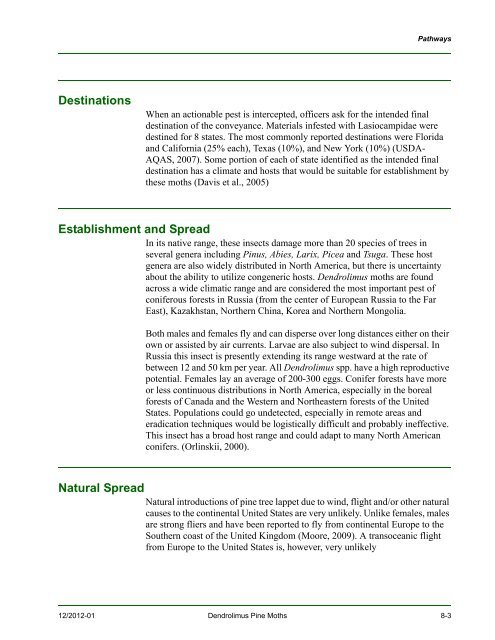New Pest Response Guidelines - aphis - US Department of Agriculture
New Pest Response Guidelines - aphis - US Department of Agriculture
New Pest Response Guidelines - aphis - US Department of Agriculture
Create successful ePaper yourself
Turn your PDF publications into a flip-book with our unique Google optimized e-Paper software.
Destinations<br />
Pathways<br />
When an actionable pest is intercepted, <strong>of</strong>ficers ask for the intended final<br />
destination <strong>of</strong> the conveyance. Materials infested with Lasiocampidae were<br />
destined for 8 states. The most commonly reported destinations were Florida<br />
and California (25% each), Texas (10%), and <strong>New</strong> York (10%) (<strong>US</strong>DA-<br />
AQAS, 2007). Some portion <strong>of</strong> each <strong>of</strong> state identified as the intended final<br />
destination has a climate and hosts that would be suitable for establishment by<br />
these moths (Davis et al., 2005)<br />
Establishment and Spread<br />
In its native range, these insects damage more than 20 species <strong>of</strong> trees in<br />
several genera including Pinus, Abies, Larix, Picea and Tsuga. These host<br />
genera are also widely distributed in North America, but there is uncertainty<br />
about the ability to utilize congeneric hosts. Dendrolimus moths are found<br />
across a wide climatic range and are considered the most important pest <strong>of</strong><br />
coniferous forests in Russia (from the center <strong>of</strong> European Russia to the Far<br />
East), Kazakhstan, Northern China, Korea and Northern Mongolia.<br />
Both males and females fly and can disperse over long distances either on their<br />
own or assisted by air currents. Larvae are also subject to wind dispersal. In<br />
Russia this insect is presently extending its range westward at the rate <strong>of</strong><br />
between 12 and 50 km per year. All Dendrolimus spp. have a high reproductive<br />
potential. Females lay an average <strong>of</strong> 200-300 eggs. Conifer forests have more<br />
or less continuous distributions in North America, especially in the boreal<br />
forests <strong>of</strong> Canada and the Western and Northeastern forests <strong>of</strong> the United<br />
States. Populations could go undetected, especially in remote areas and<br />
eradication techniques would be logistically difficult and probably ineffective.<br />
This insect has a broad host range and could adapt to many North American<br />
conifers. (Orlinskii, 2000).<br />
Natural Spread<br />
Natural introductions <strong>of</strong> pine tree lappet due to wind, flight and/or other natural<br />
causes to the continental United States are very unlikely. Unlike females, males<br />
are strong fliers and have been reported to fly from continental Europe to the<br />
Southern coast <strong>of</strong> the United Kingdom (Moore, 2009). A transoceanic flight<br />
from Europe to the United States is, however, very unlikely<br />
12/2012-01 Dendrolimus Pine Moths 8-3

















